- South Sudan has struggled to finance aviation modernization for its fledgling air force due to severe fiscal pressures. Despite security needs, the annual budget remains chronically inadequate and poorly executed. From 2021 through 2024, the government repeatedly revised spending plans upward—by as much as one-third—yet consistently failed to allocate sufficient funds for aviation asset upgrades, training, or spare parts procurement.
- Budget discipline is weak: many ministries exceeded approved limits by hundreds or even thousands of percent, especially in the finance, transport, interior, and presidential offices. This overspending was accompanied by delayed civil servant and military salary payments, hampering broader military readiness, including air force development.

Economic Instability and Revenue Shortfalls
- South Sudan’s economy—reliant on oil exports—collapsed following pipeline disruptions in neighboring Sudan, triggering a revenue crash. With oil accounting for over 90% of state revenues, the loss decimated public finances. In 2024, military spending nearly doubled to $2 billion, yet no clear portion of this was earmarked for aviation upgrades.
- The government frequently lacked hard currency, complicating procurement of aviation equipment from abroad. Critical aviation contracts—including those meant to hand over airspace control to Juba—awaited a $25 million appropriation before commissioning. That delay reflects broader difficulties in converting revenue into capital for aviation improvements.
Impacts of the UN Arms Embargo
- The UN arms embargo has severely constrained military acquisitions. South Sudan’s air fleet, once consisting of Soviet‑era Mi‑24 attack helicopters and Mi‑17 transports, suffered maintenance and operational capacity shortfalls as spare parts and training were restricted. While some helicopters appear to operate as of early 2025, evidence points to embargo violations in sourcing spares to refurbish grounded aircraft.
- This legal barrier forced training programs to stall, delayed new aircraft deliveries, and limited refurbishment efforts—all while aviation assets aged or remained grounded.
Operational and Institutional Shortfalls
- The South Sudan Air Force (SSAF) maintains a modest fleet—roughly two L‑39 trainers, one Beechcraft 1900, and several Mil Mi‑17 and Mi‑35 helicopters—but upgrading these has been largely aspirational. Given the lack of funds, little investment has gone into maintenance infrastructure, pilot training programs, or runway improvements at Juba Air Base.
- Efforts to unify and redeploy integrated national forces were also hampered by funding shortages. From 2020–22, staff training proceeded with severe resource deficits—even graduating soldiers were equipped with wooden sticks instead of arms. This reflected financial crisis across the security sector and undermined professionalization.

Governance, Transparency & Corruption Impediments
- Persistent corruption and patronage networks continue to undermine military aviation funding. Billions—especially from oil revenues—have vanished through ghost soldier schemes, inflated contracts, and non-transparent public financial controls. Public audits have revealed gross misallocation, including overspending by the finance ministry itself to the tune of 3,860% in one fiscal year.
- Opaque budget execution, off‑budget accounts for security ministries, and failure to adhere to Treasury Single Account rules further restrict viable resource flows to aviation. Despite IMF assistance and a public finance reform roadmap adopted in 2023, systems remain underdeveloped.
Safety and Regulatory Limits
- Frequent air disasters—such as crashes of aging Antonov and Let L‑410 aircraft in 2020 and 2021—underscore the lack of aviation safety investments. Lawmakers pushed reforms in 2024 to expand the Civil Aviation Authority’s capacity, bolster airworthiness checks, and update regulations. They also called for grounding aged aircraft and upgrading airstrips—critical steps tied to air force safety and operational competence.
- The construction of an air traffic management system started in 2020 and completed in late 2023, aimed at reclaiming sovereign control of airspace. Still, commissioning was stalled pending additional funds—an instance of infrastructure built but unusable due to financial delay.


